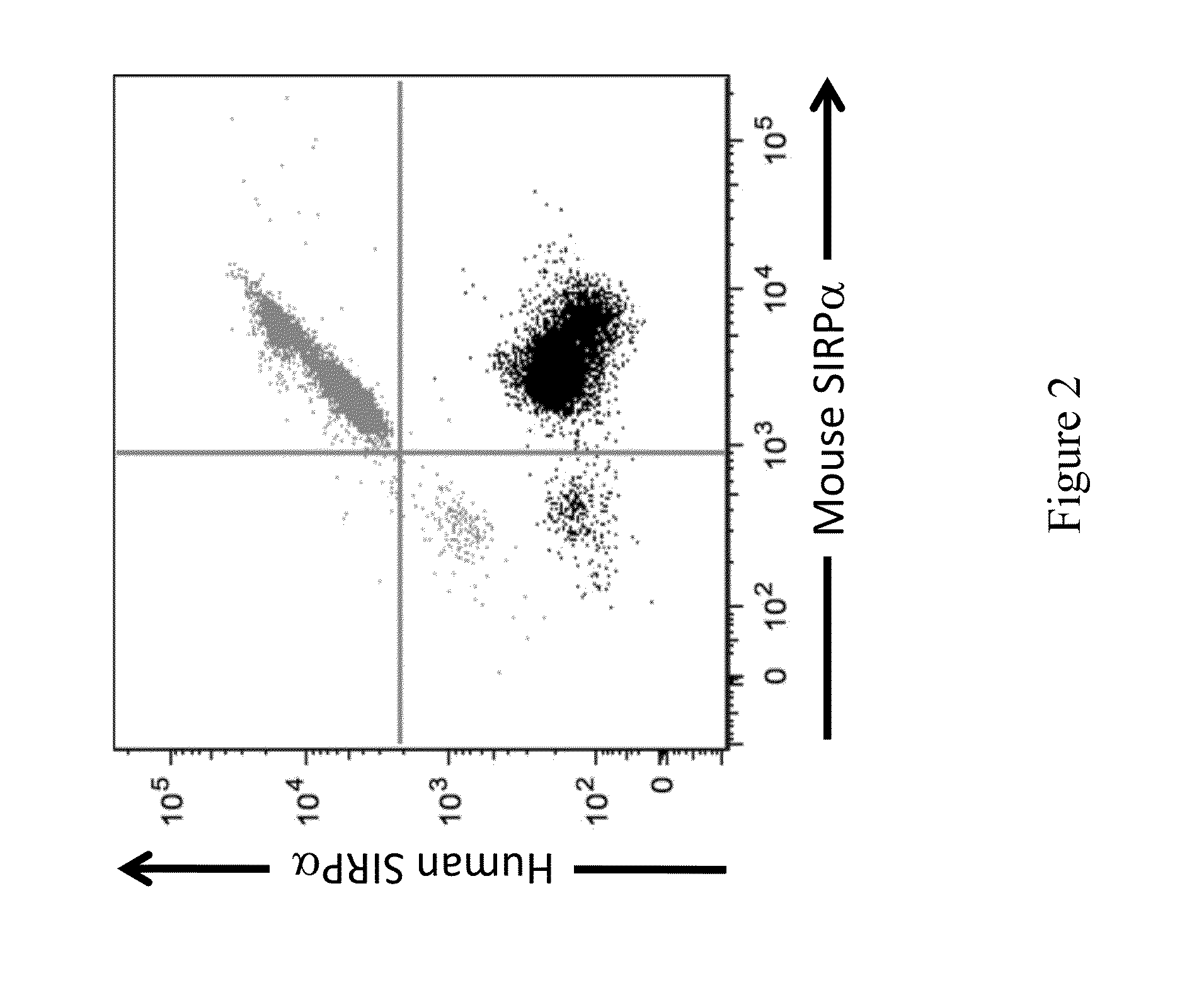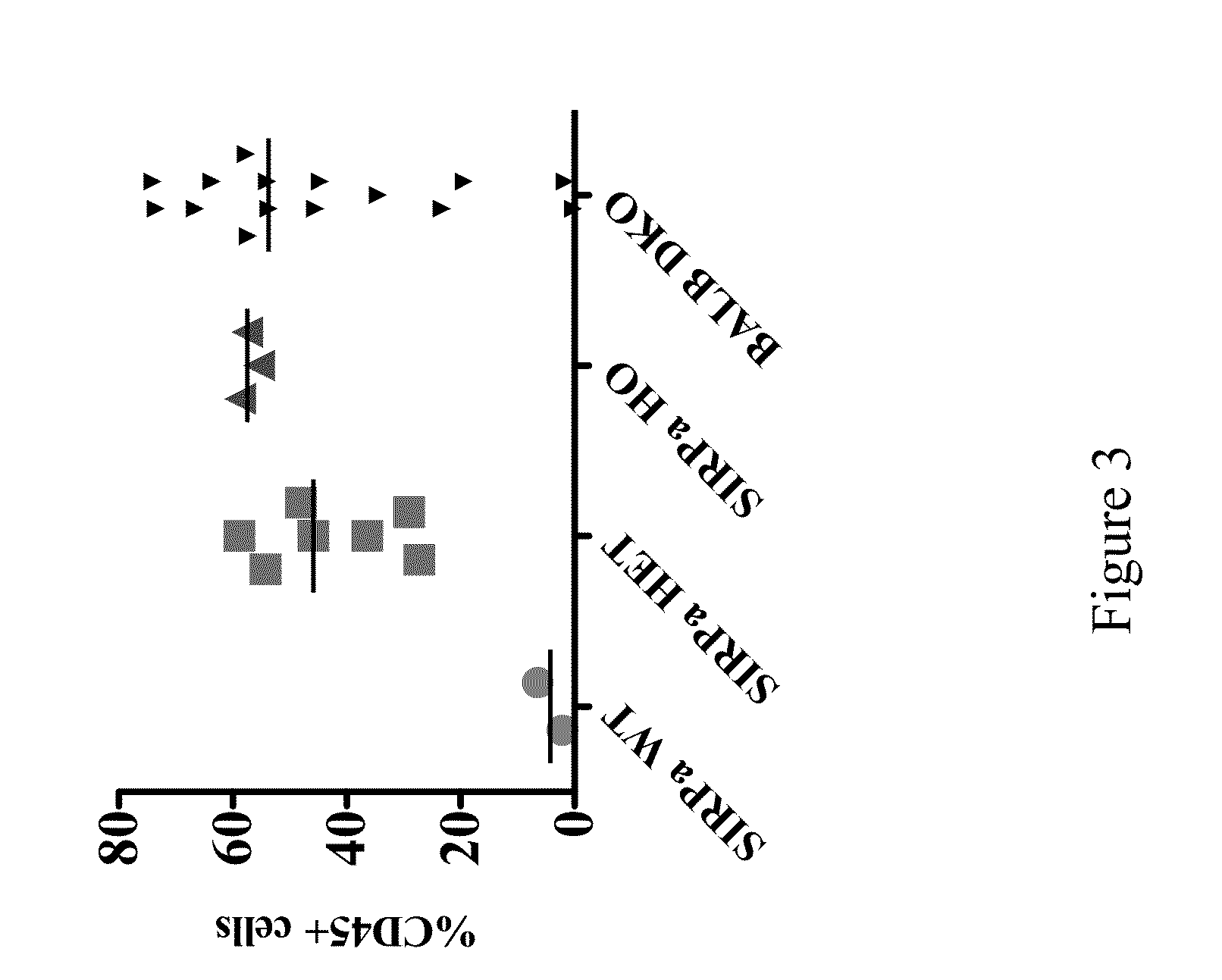Non-human animals having a humanized signal-regulatory protein gene
a signal-regulatory protein and non-human animal technology, applied in the field of non-human animals having a humanized signal-regulatory protein gene, can solve the problem that there is no in vivo system to determine the molecular aspects of human immune cell-to-cell interaction, and achieve the effects of increasing susceptibility, increasing or decreasing food consumption, and loss of function
- Summary
- Abstract
- Description
- Claims
- Application Information
AI Technical Summary
Benefits of technology
Problems solved by technology
Method used
Image
Examples
example 1
Humanization of an Endogenous Signal-Regulatory Protein (SIRP) Gene
[0115]This example illustrates exemplary methods of humanizing an endogenous gene encoding signal-regulatory protein alpha (SIRPα) in a non-human mammal such as a rodent (e.g., a mouse). Human SIRPα is known to exist in at least 10 allelic forms. The methods described in this example can be employed to humanize an endogenous SIRPα gene of a non-human animal using any human allele, or combination of human alleles (or allele fragments) as desired. In this example, human SIRPα variant 1 is employed for humanizing an endogenous SIRPα gene of a mouse.
[0116]A targeting vector for humanization of an extracellular region of a SIRP (e.g., SIRPα) gene was constructed using VELOCIGENE® technology (see, e.g., U.S. Pat. No. 6,586,251 and Valenzuela et al. (2003) High-throughput engineering of the mouse genome coupled with high-resolution expression analysis, Nature Biotech. 21(6):652-659).
[0117]Briefly, mouse bacterial artificial...
example 2
Expression of Humanized SIRPα in Non-Human Animals
[0123]This example illustrates the characteristic expression of SIRPα protein on the surface of cells from non-human animals engineered to contain an humanized SIRPα gene construct as described in Example 1 at an endogenous SIRPα locus.
[0124]Briefly, spleens were isolated from wild type (WT) and mice heterozygous for a humanized SIRPα gene. Spleens were then perfused with Collagenase D (Roche Bioscience) and erythrocytes were lysed with ACK lysis buffer according to manufacturer's specifications. Cell surface expression of mouse and human SIRPα was analyzed by FACS using fluorochrome-conjugated anti-CD3 (17A2), anti-CD19 (1D3), anti-CD11b (M1 / 70), anti-human SIRPα (SE5A5), and anti-mouse SIRPα (P84). Flow cytometry was performed using BD LSRFORTESSA™. Exemplary expression of human and mouse SIRPα as detected on the surface of CD11b+ monocytes is shown in FIG. 2.
[0125]As shown in FIG. 2, expression of both mouse and humanized SIRPα we...
example 3
Human Cell Engraftment in Humanized SIRP Non-Human Animals
[0126]This example illustrates an improved engraftment of human hematopoietic stem cells in non-human animals of the present invention having a humanized SIRPα gene.
[0127]Briefly, Rag2 KO IL2Rγnull mice with or without a humanized SIRPα gene were raised under pathogen-free conditions. Newborn mice (2 to 5 days old) were irradiated with 240 cGy and injected intra-hepatically with 1×105 CD34+ human hematopoietic stem cells. The mice were bled 10 to 12 weeks post engraftment and blood was analyzed by FACS using fluorochrome-conjugated anti-human CD45 (HI30), anti-human CD3 (SK7), anti-human CD19 (HIB19) and anti-mouse CD45 (30-F11) to check for the reconstitution of the human immune system. The genetic background of the mice is BALB / cTa×129 / SvJae.
[0128]Exemplary percentages of human CD34+ cells in wild type, mice heterozygous for humanized SIRPα, mice homozygous for humanized SIRPα and BALB-Rag2− / −IL2Rγc− / − (DKO) mice are shown ...
PUM
| Property | Measurement | Unit |
|---|---|---|
| Therapeutic | aaaaa | aaaaa |
Abstract
Description
Claims
Application Information
 Login to View More
Login to View More - R&D
- Intellectual Property
- Life Sciences
- Materials
- Tech Scout
- Unparalleled Data Quality
- Higher Quality Content
- 60% Fewer Hallucinations
Browse by: Latest US Patents, China's latest patents, Technical Efficacy Thesaurus, Application Domain, Technology Topic, Popular Technical Reports.
© 2025 PatSnap. All rights reserved.Legal|Privacy policy|Modern Slavery Act Transparency Statement|Sitemap|About US| Contact US: help@patsnap.com



